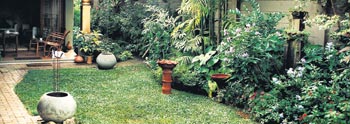
| No rain goes in vain With a love for the environment and a passion for gardening, the Wickremeratnes’ colourful garden is a proud product of rain water harvesting Ralph Wickremeratne’s garden, profuse with colourful blossoms and lush foliage is a joy to behold. It is watered regularly from the reserves captured from an innovative rain water harvesting system designed by him. Here’s how the system based on simple technology works: Rain water from the roof is channelled down through pipes into large pots that have an opening at the base. Underground pipes that are connected to the pots carry water into a sunken 1000 gallon plastic container. A motor pump provides the required pressure to water plants through a hose.
“We use rain water to water the entire garden,” Mr. Wickremaratne states, describing their domestic water system that harnesses as much rain water as possible in an effort to conserve water and reduce escalating water bills. Environmental issues and conservations of resources have always interested Mr. Wickremaratne who was constantly aware of the need to protect environmental treasures and use them sparingly and with care. It began during his planter days when he recalls memories of rain water gushing down ravines and drains taking with it rich top soil in the wettest areas of Ratnapura and Watawala. “No thought was given to storing rain water for a ‘dry’ day,” he adds, “until droughts caused by changing weather patterns became more frequent.” Thereafter having lived in Australia for 26 years, Mr. Wickremaratne was amazed that in the harsh weather conditions there, an abundant supply of water was assured purely because of a good collection and storage system.
Residents strictly adhered to the days and timings (between 6 and 8 p.m. on alternate days) when they could water their gardens or wash their cars. “They were conscious about conserving resources, not just the scarce ones,” he explains. Hence cars were washed on a lawn, simultaneously watering the grass. Mr. Wickremaratne and his wife, Dr. Sriyani Basnayake who share a passion for gardening told their architect during the building of their house a year ago about the system they required. Costing about Rs. 75,000, it has served to collect about 80,000 litres in the last year in the underground tank, allowing for the excess water to flow into the open street drains. “In an emergency, the water can be diverted for other household purposes,” he adds.
“If more people do the same, we can save so much water and there will be no water flooding our roads during the monsoon,” Dr. Basnayake says. It is no flashy technology but a simple technique that is maintenance free. “We only need to pray for rain.” Even those who are not building can install within their premises a system that can divert water from the gutters into an external tank. Painted with a brick design, the tank could make a delightful installation with potted plants arranged around it. “We wouldn’t have a garden like this
if it wasn’t for our system,” Dr. Basnayake says talking
about the pleasure they derive from seeing something growing. A
small patch accommodates the kitchen garden, providing them with
the frequently required curry leaves, greens, chillies, etc. In
addition they have compost bins that convert their entire kitchen
refuse into manure. “Water here is plentiful. If everyone
makes an effort we do not need to depend on the government so much,”
Dr. Basnayake adds. |
| || Front
Page | News
| Editorial
| Columns
| Sports
| Plus
| Financial
Times | International
| Mirror
| TV
Times | Funday
Times | |
| |
Copyright
2006 Wijeya
Newspapers Ltd.Colombo. Sri Lanka. |


